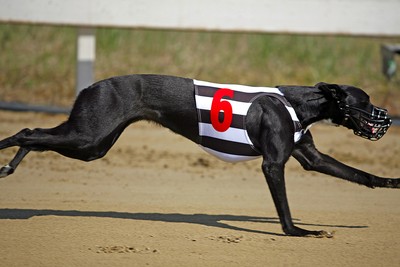 Horse racing fans will be no strangers to handicap races, with the majority of UK events falling into this category. For the uninitiated, in horse racing, a handicap race is a contest in which each runner must carry a weight directly related to their Official Rating. This Official Rating is a numerical value assigned by the official handicapper and is designed to reflect a horse’s ability.
Horse racing fans will be no strangers to handicap races, with the majority of UK events falling into this category. For the uninitiated, in horse racing, a handicap race is a contest in which each runner must carry a weight directly related to their Official Rating. This Official Rating is a numerical value assigned by the official handicapper and is designed to reflect a horse’s ability.
The higher their Official Rating, the more weight a horse must carry in relation to its rivals. The aim of a handicap race is to slow the more talented performers down, giving those with less ability more chance to win and – at least in theory – creating a level playing field and attractive betting contest.
And what is good enough for the Sport of Kings is good enough for its little brother, greyhound racing. Handicap contests also feature as part of the regular Greyhound Racing Programme, being particularly popular at northern tracks and less so in the south. However, as we shall see, the manner in which dogs are handicapped is rather different to the system used for their larger four-legged racing cousins.
How are Dogs Handicapped?
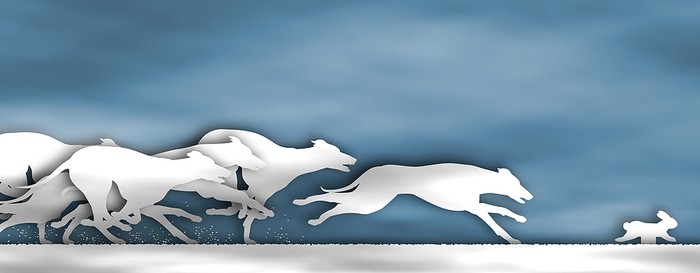
Whereas in racing, a level playing field is created by adjusting the weights to be carried by each of the runners, any attempt to replicate this method in the greyhound world would likely prove impractical for a number of reasons.
Firstly, no comparable Official Ratings system exists in greyhound racing, creating the problem of determining how much weight would need to be carried by each of the runners. Secondly, and most significantly, dogs never race with any weight on their backs anyway. Attempting to add weighted cloths to these relatively small, slim creatures would prove impractical and possibly dangerous, considering the speeds at which they travel around the tight bends of a greyhound track.
So, if not via a weight-related system, how are dogs handicapped? In the end, the obvious answer proved to be the most sensible solution. In a handicap dog race, the slower animals are simply given a head start over their quicker rivals.
How Does Handicapping Work?
![]()
In a handicap dog race, the quickest dog will start in trap six, which will, as usual, lie towards the outside of the track and on the correct starting line for the distance of the race. The dog in Trap 6 is known as the “scratch” dog. This term “scratch” refers to the starting line and stems from the earliest running events, when the start line would, quite literally, have been little more than a scratch in the ground.
All other dogs in this race are then handicapped relative to the scratch dog and assigned a head start in metres by the Racing Manager at the track. When calculating these handicaps, the Racing Manager will use a system largely based on the previous race times of the contenders. Greyhounds can reach maximum speeds of 43mph, which equates to 20m per second. Therefore – as a very rough guide – a dog which had previously completed a race over the distance in a time 0.5s slower than the time recorded by the scratch dog may receive a 10m head start.
Having been handicapped, these dogs are then ranked, with the second fastest dog starting in Trap 5, the third fastest in Trap 4, and so on, down to the slowest animal in Trap 1. Occasionally, two dogs may be judged of equal ability and receive the same handicap for a race. Whenever this occurs, a random draw will take place to assign the trap numbers of the dogs involved.
Trap Layout
When laying out the Traps ahead of a handicap, all Traps will be placed at their usual distance from the rail. As such, Trap 1 will be up against the inside rail, moving out to Trap 6 on the outside. However, Traps 1 through 5 will then be moved forward from the start line by the number of metres determined by their handicap.
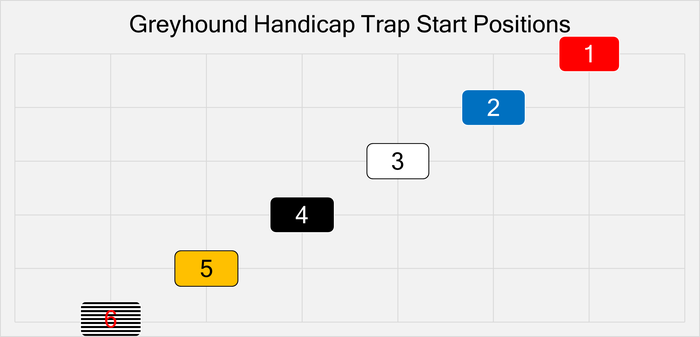
One impact of this system is that only the scratch dog will run the full race distance listed. All other dogs will run the listed race distance minus their handicap in metres. Once the race begins, all traps open simultaneously, just as they do in a non-handicap race.
Handicap Race Example
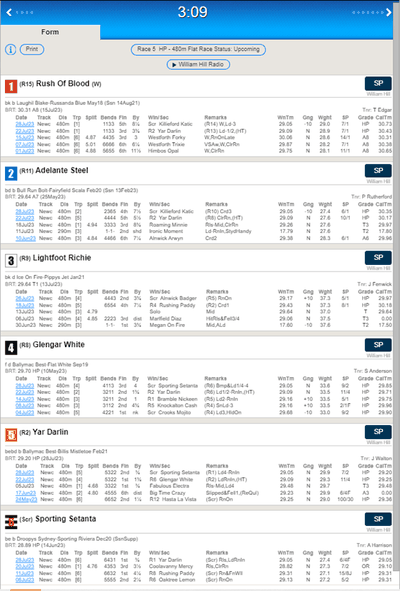 The image shows the race card for a 2023 handicap held at the North East track of Newcastle.
The image shows the race card for a 2023 handicap held at the North East track of Newcastle.
As in the example, Handicap events will always be identifiable by the letters (HP), (H) or (Hcp) listed beside the distance of the race.
The head start received by each runner is found beside their race card number. Running through the Newcastle field from bottom to top, we can see that Trap 6 Sporting Setanta is the Scratch (Scr) dog for the race.
Moving on to Trap 5 Yar Darling, the (R2) annotation informs us that he will start 2m in front of Trap 6. Glengar White (R8) will receive an 8m start over Trap 6, and so on, down to slow coach Rush Of Blood in Trap 1, who will start fully 15m in front of Sporting Setanta.
Which Dogs Run in Handicap Races?
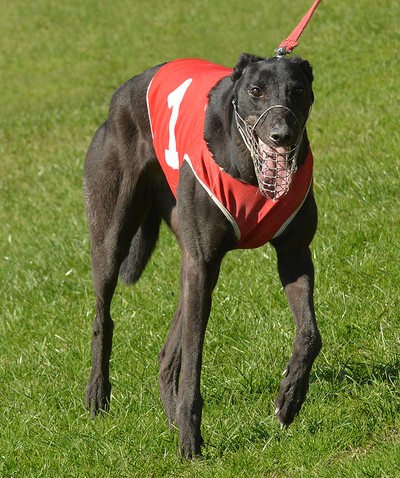 Much like in horse racing, the majority of greyhound handicap races tend to be contested by runners of low to middling ability.
Much like in horse racing, the majority of greyhound handicap races tend to be contested by runners of low to middling ability.
The more talented Graded performers will tend to stick to the higher-Grade races run under standard conditions before progressing to Open races, which are the rough equivalent of Listed/Group class horse racing events.
Whilst handicaps dominate the horse racing scene, they take place far less frequently in the world of dog racing.
Taking an average 12-14 race card as an example, you might expect to find just one or possibly two handicap events, but very rarely any more than this.
